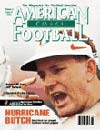AMERICAN FOOTBALL MONTHLY THE #1 RESOURCE FOR FOOTBALL COACHES
Article CategoriesAFM Magazine
|
Do It Your WayDeveloping a passing attack that fits your plans and playersby: Charlie Stubbs Quarterbacks Coach, University of Alabama © More from this issue Throughout my twenty-two years in the profession, I have had the opportunity to coach at both the collegiate and high school levels. During that time, I have had the pleasure of working with various coaching staffs that have helped me formulate my philosophies on dealing with the passing game. At the same time, I have coached many athletes with various ranges in athletic abilities. Therefore, I have had to adapt each year to the specific situation. When you are developing a passing attack, it is important to build a system that fits your athletes' abilities and to get your best 11 players on the field! Remember: A Style Of Your Own! EVALUATE YOUR PERSONNEL It is important to evaluate all of your offensive positions - Not Just Your Quarterback. This will enable you to blend their strengths together to get 11 players execu....The full article can only be seen by subscribers.
|
|
|||||||
| HOME |
MAGAZINE |
SUBSCRIBE | ONLINE COLUMNISTS | COACHING VIDEOS |
Copyright 2026, AmericanFootballMonthly.com
All Rights Reserved





